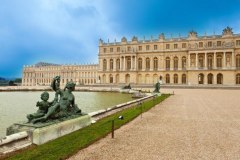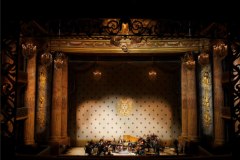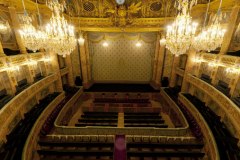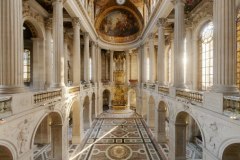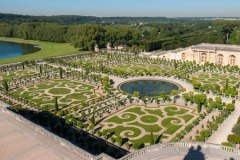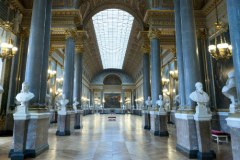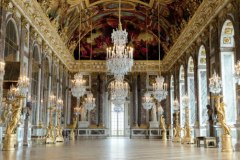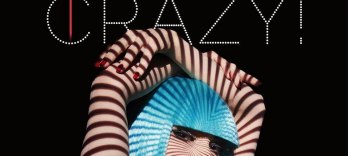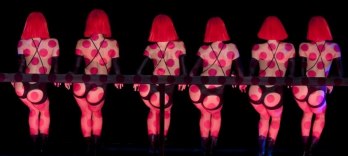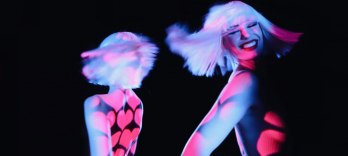Vivaldi: The Four Seasons
July 2024 | ||||||
|---|---|---|---|---|---|---|
Mo | Tu | We | Th | Fr | Sa | Su |
What if the Antonio Vivaldi’s famous Four Seasons (1678-1741), published in Amsterdam in 1725 and performed in Paris at the Concert Spirituel in 1728, had been preceded by those of Giovanni Antonio Guido (1675-1729), star violinist of Parisian orchestras of the maturity of Louis XIV, and Master of Music of the Regent Philippe D'Orléans, published in Versailles? The two works are finally presented in the same programme in spite of their differences: the well-known virtuosity of Vivaldi's work contrasts with the mixture of French good taste and Italian features of Guido's Seasons; before the very descriptive poem illustrated by Vivaldi's music with remarkable naturalism, Guido paid homage to each season, with a display of affects worthy of the French court.
To a great extent, Guido remains a mysterious musician, due to a lack of archives. Born around 1675, he was listed among the violin students of the Conservatorio della Pietà dei Turchini, in Naples, then among the musicians of the Royal Chapel, until 1702. He left for Paris and entered the service of Duke Philippe d'Orléans, future Regent of France and a great music lover, and became his Master of Music. He met Morin, Gervais and Forqueray, and contributed to introducting Italian music in France. He also entered the circle of the financier Pierre Crozat and gave concerts at his residence where Watteau and the banker Law were also visitors. Between 1713 and 1716, Crozat decided to redecorate his dining room and asked Watteau to paint four paintings on the theme of the seasons. It was probably to pay homage to this admirable new ensemble that Guido composed around 1717 his "Scherzi armonici sopra le Quattro stagioni dell'anno", based on four anonymous poems: Les Caractères des Saisons. Each of these "musical entertainments" had about ten movements, and even if it is called a concerto, it also resembles a French suite: the music is a clever mixture of Italian and French. The publication of Guido's Seasons in Versailles does not bear a date, but is thought to date from the period 1725-1733. In any case, Guido's Seasons are contemporary with Vivaldi's famous Seasons, perhaps a little earlier. So, who inspired whom?
Program and cast
Henry Purcell (1659-1695)
Timon of Athens (Timon d’Athènes) : Curtain Tune (Air du rideau)
Antonio Vivaldi
Primavera : Allegro – Largo – Allegro
Giovanni Guido
Le Printemps : Le temps vole – Chaque saison s’enfuit – Les ruisseaux – Muzete – Danse des Bergers
L’Este : L’air s’enflamme – Zéphire desparoit – Chant des Coucous – Vole à notre secours O ! Cérès adorable – Un violent orage
Antonio Vivaldi
L’Estate : Allegro non molto allegro – Adagio presto adagio – Presto
Giovanni Guido
L’Automne : La Chasse
Antonio Vivaldi
L’Autunno : Allegro – Adagio molto – Allegro
Giovanni Guido
L’Hyver : La saison des frimats – Les riantes fêtes – Laissons gronder les vents
Antonio Vivaldi
L’Inverno : Allegro non molto – Largo – Allegro
Palace of Versailles Opera Theater
Royal Opera
The Royal Opera of Versailles, located in the grounds of the Castle, one of the major opera houses.
The opening of the opera house at Versailles brought to a close a process of planning, projects and designs that had lasted for nearly a century. While the Royal Opera was finally built towards the end of the reign of Louis XV, it had been envisaged since as early as 1682, the year when his predecessor Louis XIV took up residence at Versailles. The King had commissioned Jules Hardouin-Mansart and Vigarani to draw up plans for a ballet theatre. Mansart shrewdly decided on a position at the far end of the new wing that was to be built over the coming years: the nearby reservoirs for the gardens’ fountains could be used to fight any fire that might break out, while the sloping ground on that part of the site would allow provision of the necessary technical spaces below the stage without major excavation work. So cleverly-chosen, indeed, was the planned location that none of Mansart’s successors ever questioned it.
Major building work was already under way in 1685, but was soon interrupted because of the wars and financial difficulties which beset the later part of the king’s reign. Louis XV in his turn was long put off by the huge expense involved in the project. As a result, for almost a century the French court was forced to put up with a makeshift theatre installed below the Passage des Princes. When a grand opera was required, with a large cast and complicated stage machinery, a temporary theatre would be built in the stables of the Grande Ecurie, with the entire structure being demolished once the performances were over. This temporary solution was adopted, for instance, during the celebrations of the Dauphin’s wedding in February 1745, but its inconvenience was so starkly obvious that Louis XV finally resolved to build a permanent theatre, entrusting its design to his first architect, AngeJacques Gabriel.
The process of actually building the new theatre, however, was to take over twenty years. During this lengthy period of construction Gabriel, who had studied the leading theatres of Italy, in particular Vicenza, Bologna, Parma, Modena and Turin, presented a series of different designs to his royal patron, none of which was accepted. Only in 1768, faced with the forthcoming successive marriages of his grandchildren, did the king finally give the order for work to commence. Building progressed steadily and the new opera house was completed in twenty-three months, ready for its inauguration on the 16th of May 1770, the day of the Dauphin’s marriage to the Archduchess Marie-Antoinette, with a performance of Persée by Quinault and Lully.
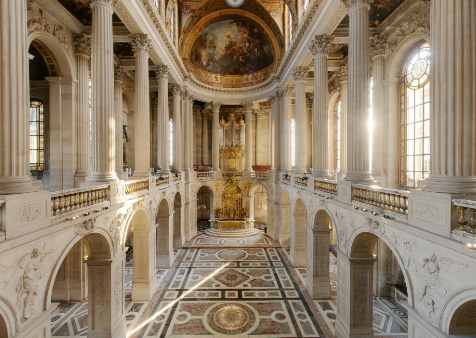
Royal Chapel
This extraordinary two-level palatine chapel was built by Jules Hardouin Mansart between 1699 and 1708 and completed by Robert de Cotte in 1710.
The paintings on the vaulted ceiling by Antoine Coypel, Charles de la Fosse and Jean Jouvenet, as well as the lavish decoration fashioned by a team of sculptors working for Louis XIV, depict a number of Old and New Testament scenes. Facing the royal gallery is the remarkable organ, created by Robert Clicquot, the King's organ builder, which was first played on Easter Sunday 1711 by François Couperin.
Even though Hardouin-Mansart did not witness the completion of the chapel, he was the one who had dictated the major aspects of the architecture and decor: a ground floor with a nave, aisles and ambulatory, and an upper floor with galleries, a harmonious combination of white and gold contrasting with the polychromatic marble floor and paintings on the vaulted ceiling, all combining to create an original space with references to both gothic architecture and baroque aesthetics.
Every day, generally at 10 a.m., the court would attend the King's mass. The King would sit in the royal gallery, surrounded by his family, while the ladies of the court would occupy the side galleries. The "officers" and the public would sit in the nave. The King would only descend to the ground floor for important religious festivals when he would take communion, for Order of the Holy Spirit ceremonies and for the baptisms and weddings of the Children of France, which were celebrated there between 1710 and 1789. Above the altar, around the Cliquot organ played by the greatest virtuosos of their age, including François Couperin, the Chapel Choir, renowned throughout Europe, would sing motets throughout the entire service, every day.
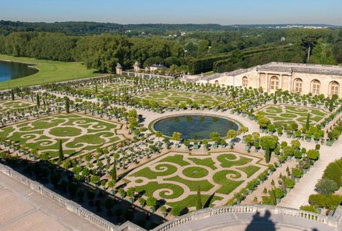
The Orangerie gardens
From May to October, orange trees and other shrubs are taken out of the Parterre Bas of the Orangerie gardens. At the center of this parterre, there is a large circular pool surrounded by six sections of lawn.
Orangerie
A great stone cathedral within a formal garden, The Orangerie is both a royal and magical place.
Built between 1684 and 1686 by Jules Hardouin-Mansart to house and protect precious trees and shrubs during the Winter, this extraordinarily large building is located beneath the parterre du Midi (South flowerbed), for which it acts as a support. Two monumental staircases, known as "les Cent Marches" (the hundred steps), frame the Orangerie's three galleries, which overlook the parterre where, during the Summer, more than 1,200 exotic trees are arranged.
Performances: Su 26 May 2024,
Performances: Mo 13 May 2024,
Performances: Th 16 May 2024,
Performances: Mo 13 May 2024,
Performances: Mo 13 May 2024,
Performances: Th 16 May 2024,

 EN
EN DE
DE IT
IT FR
FR ES
ES RU
RU JP
JP RO
RO
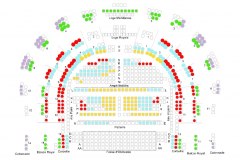 Seating plan
Seating plan 